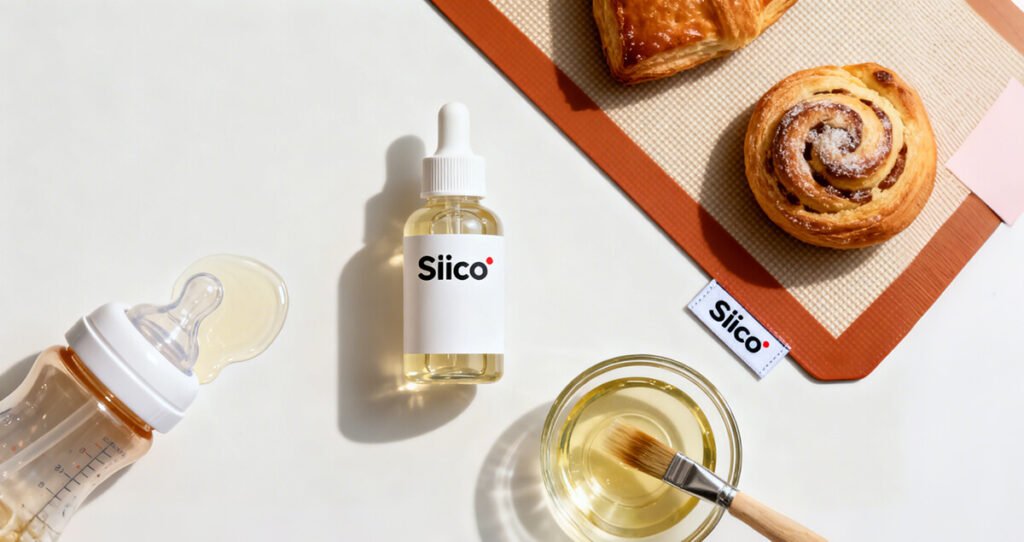How to Choose Food-Grade Silicone Oil
- Blog
- May 28, 2023
- 2:21 pm
Selecting the right food-grade silicone oil is essential for ensuring food safety, equipment reliability, and regulatory compliance in food processing and packaging industries. This guide provides a comprehensive overview of Silico® Food-Grade Silicone Oils, including definitions, international standards (NSF, FDA, EU FCM), key performance indicators, and practical selection strategies. Learn how to evaluate viscosity, purity, and migration limits, verify supplier certifications, and choose the most suitable silicone oil for baking, beverage filling, or machinery lubrication. With Silico®, manufacturers can achieve optimal lubrication performance while meeting global food-contact safety requirements.
Table of Contents
- 1. Introduction: Why the Food Industry Needs Food-Grade Silicone Oil
- 2. Definition & Core Regulatory Standards
- 3. Main Types and Application Fields
- 4. Key Performance Indicators & Selection Parameters
- 5. Silicone Oil Selection Strategies for Different Applications
- 6. Food Safety and Compliance Evaluation
- 7. Laboratory and On-Site Testing Recommendations
- 8. Procurement & Quality Control Checklist
- 9. Frequently Asked Questions (FAQ)
- 10. Conclusion & Selection Recommendations
1. Introduction: Why the Food Industry Needs Food-Grade Silicone Oil
In food processing, packaging, and equipment lubrication, all lubricants must pose zero risk to food safety.
Food-grade silicone oil stands out for its high stability, odorless and tasteless nature, low volatility, and chemical inertness, making it a preferred lubricant in the food and beverage industry.
Compared to standard industrial silicone oils, food-grade silicone oils must not only perform technically but also comply with stringent international food-contact regulations such as NSF, FDA, and EU FCM standards.
💡 Silico® Food-Grade Silicone Oils are formulated to meet NSF H1 and FDA 21 CFR requirements, providing trusted performance and compliance for global food manufacturing applications.
2. Definition & Core Regulatory Standards
Food-grade silicone oil typically refers to high-purity Polydimethylsiloxane (PDMS), used as a lubricant, release agent, or defoaming agent under strictly controlled conditions.
Key Regulatory References:
FDA (U.S.) — Certain PDMS grades are approved for use as defoamers or lubricants in food processing (21 CFR 173.340), provided they meet defined purity and molecular weight criteria.
EU (Europe) — Under (EC) No.1935/2004 and (EU) No.10/2011, silicone oils must pass migration testing and not alter food taste or odor.
NSF Certification — NSF H1 (incidental food contact) and NSF 3H (direct food contact) are widely recognized certifications for food-grade lubricants.
ISO 21469 — Specifies hygienic manufacturing practices for lubricants used in food-related equipment.
✅ Professional Tip:
Before purchasing, request from suppliers: NSF certificate number, CoA, TDS, and a Declaration of Compliance (DoC) to ensure traceability and regulatory conformity.


3. Main Types and Application Fields
| Type | Typical Viscosity (25°C) | Main Use | Characteristics |
|---|---|---|---|
| PDMS Silicone Oil | 10–10,000 cSt | Lubrication, release, defoaming | High stability, odorless, cost-effective |
| Modified Silicone Oil | 100–10,000 cSt | Special lubrication or adhesion needs | Enhanced compatibility and surface control |
| High-Temperature Silicone Oil | 200–500 cSt | Baking, frying, and high-temp processing | Excellent thermal stability, low volatility |
| Emulsified Silicone Oil | Custom | Defoaming or process liquid systems | Good dispersibility and compatibility |
Typical Applications:
Lubrication of food processing machinery (conveyors, slides, bearings)
Mold release for baking and confectionery
Defoaming in fermentation or frying processes
Beverage filling and packaging line lubrication
Anti-stick coatings for food packaging materials
Silico® offers customized food-grade silicone oil formulations to meet the demands of high-temperature baking, beverage bottling, and food packaging environments.
4. Key Performance Indicators & Selection Parameters
1. Physical Parameters
- Viscosity (cSt): Affects lubrication and release properties (common range: 50–1000 cSt)
- Viscosity Index (VI): Indicates stability against temperature changes
- Specific Gravity & Expansion Coefficient: Impacts sealing and compatibility
- Volatility: Determines performance under heat exposure
2. Safety & Compliance Parameters
- Purity: ≥99.8% PDMS
- Migration Testing: Within legal limits
- Odor, Color, and Sensory Stability
- CoA Reports: Must include residual low-molecular silicone and heavy metal content
5. Silicone Oil Selection Strategies for Different Applications
| Application | Recommended Type | Viscosity Range (cSt) | Key Requirements |
|---|---|---|---|
| Baking mold release | High-temp PDMS or modified silicone oil | 350–1000 | Heat-resistant, low migration |
| Frying defoaming | Emulsified silicone oil | 50–100 | Strong antifoam stability |
| Beverage filling lubrication | NSF H1 silicone oil | 100–350 | Low odor, wear resistance |
| Food packaging machinery | Modified PDMS | 200–500 | Excellent material compatibility |
6. Food Safety and Compliance Evaluation
- Regulatory Compliance: Meets FDA, EU, or GB food-contact standards.
- Migration Testing: Simulates contact with fatty, acidic, and alcoholic foods.
- Sensory Impact: Should not affect food color, taste, or odor.
- Equipment Compatibility: Confirm suitability with metals, plastics, and elastomers.
- Clean-in-Place (CIP) Validation: Ensure full removability after cleaning cycles.
7. Laboratory and On-Site Testing Recommendations
| Test Item | Purpose | Standard/Method |
|---|---|---|
| Viscosity & Volatility | Stability verification | ASTM D445, D972 |
| Migration Testing | Food safety validation | GB 31604 / EU 10/2011 |
| Sensory Testing | Odor and taste neutrality | ISO 4120 (Triangle Test) |
| Material Compatibility | Seal resistance | ISO 1817 |
| Microbial Testing | Hygiene verification | ISO 21149 |
💡 Recommendation:
For new suppliers or new silicone oil grades, conduct at least three production trials and one third-party lab comparison to ensure long-term consistency.
8. Procurement & Quality Control Checklist
- TDS (Technical Data Sheet)
- CoA (Certificate of Analysis)
- NSF/ISO 21469 Certifications
- DoC (Declaration of Compliance)
- MSDS (Safety Data Sheet)
- Verify viscosity and purity within tolerance
- Match batch number with certificates
- Check packaging integrity and labeling
- Random sampling for migration, volatility, and odor testing
9. Frequently Asked Questions (FAQ)
A1: Food-grade silicone oil undergoes purification and certification, ensuring ultra-high purity, odorless and tasteless characteristics, and controlled migration—industrial silicone oils do not meet these food safety standards.
A2: Only products with NSF 3H or FDA approval can be used in direct contact, under defined concentration and temperature conditions.
A3: Not necessarily. Excessive viscosity reduces flowability and may impair lubrication efficiency. Select viscosity based on temperature, contact type, and process speed.
A4: Compliant products should be neutral. Improper dosage or poor-quality oil may cause minor sensory deviations.
10. Conclusion & Selection Recommendations
Food-grade silicone oil plays an essential role in food processing, packaging, and equipment lubrication.
When selecting, consider the three critical factors below:
Regulatory Compliance — Choose oils with NSF/FDA/ISO certifications.
Technical Performance — Match viscosity and formulation to your process requirements.
Supply Consistency — Partner with reliable brands to ensure batch-to-batch stability.
✅ Recommendation:
Choose reputable brands like Silico® Food-Grade Silicone Oil, certified to NSF H1 and FDA 21 CFR, ensuring full traceability and reliable long-term performance in food manufacturing environments.
Popular Recommendations
Get a Catalog & Best Price
- Quick and helpful reply within 24 hours;
- Tailored solutions provided for your project;
- One-stop purchasing service.
TRENDING
Silico® ORGANOSILICON
- Address: Daiyue Industrial Area, Taian, Shandong, China



